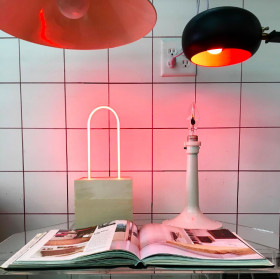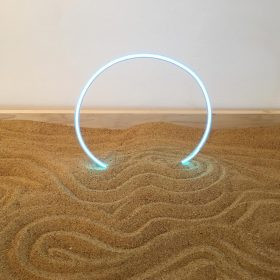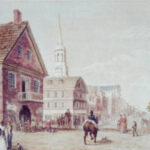Anahita Bradberry’s captivating neon sculptures, usually found illuminating galleries and studios, are set to make a vibrant debut in the open air at the Hester Street Fair. Known for their sleek lines and mesmerizing glow, her pieces from Studio Sour bring a fresh perspective to neon art, moving beyond the typical commercial associations to reveal a dynamic and almost living quality within the light itself. Bradberry’s journey into neon began unexpectedly, sparked by an apprenticeship where she traded paperwork for glassblowing lessons. This hands-on mentorship opened up a world of bending glass and electrifying rare gases, a traditionally exclusive art form. Now, based in Brooklyn, her Greenpoint studio serves as both her creative workspace and a welcoming storefront, drawing in passersby with its radiant allure.
 Neon art piece by Anahita Bradberry
Neon art piece by Anahita Bradberry
While neon is often linked to the starkness of urban commercial signs, Bradberry sees a different narrative within its glowing tubes. She perceives an inherent vitality, an energy that is far from cold and sterile. “It has, at once, defined our commercial cultural experience in the city,” she reflects, “and is also the most amazing example of light quality.” As she prepares to showcase her art at the Hester Street Fair’s opening day this Saturday – with pieces available at a special price range of $175-$300, discounted from their usual gallery prices – we delve into a conversation with Ani to uncover the often-misunderstood essence of neon and why it might be the transformative element your living space is missing.
 Green neon art piece by Studio Sour
Green neon art piece by Studio Sour
Inside Studio Sour: Minimalist Neon with a Contemplative Edge
Could you share more about Studio Sour and the distinct style of neon art you create there?
Studio Sour functions as a dual space: it’s both where I pursue my artistic explorations and operate my storefront. My focus is on crafting meditative experiences through colored light, embodied in minimalist designs. The beauty of neon lies in its inherent duality; it’s simultaneously organic—composed of rare gases electrified at high voltage—and yet meticulously handcrafted. Each glass tube is hand-blown, carefully shaped, and then encased in simple wooden structures.
The storefront aspect is dedicated to offering artful objects for the home, specifically lamps designed for those seeking moments of contemplation within their personal space. It originated from a desire to make my art more accessible and affordable, ensuring it’s not only easy to purchase but also simple to integrate into any home. They require nothing more than a standard electrical outlet.
The Power of Minimal Neon: Letting the Light Speak
What draws you to minimalist aesthetics in your neon work?
Neon itself possesses such a rich and captivating quality that I strive to let it express itself fully, without unnecessary embellishment. Often, neon is dismissed as a mass-produced commercial element, but the reality is that every piece, even the ubiquitous “OPEN” signs, is painstakingly hand-blown. This handcrafted nature is truly remarkable, and the medium itself is inherently extraordinary.
While neon art in fairs often leans towards text-based pieces—single words or phrases—I find myself less interested in that direction, with the exception of perhaps Farsi script. I believe it’s time to appreciate the pure form of this light source, a technology and technique that has remained virtually unchanged for a century. My aim is to empower each piece with its own presence, allowing it to stand alone and communicate its essence directly.
Alive and Dynamic: The Agency of Neon Art
You mentioned your pieces having an “agency of their own.” Can you elaborate on that?
I’m fascinated by the idea that these neon pieces possess a life-like quality. They interact with their environment, shifting in appearance throughout the day depending on the ambient light—both natural sunlight and artificial indoor lighting. In a dimly lit room, a neon piece can feel expansive, filling the space with its glow, almost like a gas spreading. In brighter gallery settings, it can take on a denser, almost jelly-like texture. I appreciate this element of chance and unpredictability. Most people glance at neon signs without truly observing them, but if you look closely, you’ll notice fascinating details like beading patterns within the tubes—tiny beads of gas moving in formations, or the gas itself subtly undulating. These are random, playful occurrences.
Ultimately, they are handmade light bulbs, and like all bulbs, they have a lifespan. While some may last for decades, others might only glow for five to fifteen years. This impermanence is unpredictable and is a concept I explore more deeply in my broader art practice. I consider them almost as living, breathing entities. Often, I shape them into biomorphic forms, reflecting this sense of inherent vitality.
 Neon art installation with water element
Neon art installation with water element
Exploring Vitality: Neon as Life Force
How do you explore this concept of vitality in your larger conceptual installations?
I often seek to create a physical engagement with the viewer. For instance, in a past exhibition at Gallery 102 in Washington, D.C., which focused on the fluid journeys of immigrants and refugees, I created a large neon arc that descended into a cube of water. The visual effect is intentionally unsettling—electrified light submerged in water. While perfectly safe due to insulation, to an untrained eye, it evokes a sense of risk. I was interested in placing the viewer in a state of heightened awareness and slight unease.
My background has instilled in me a deep appreciation for fluidity and life force. My Iranian heritage, particularly through my mother who immigrated to the US as a child, has been a significant influence. Iranian culture is rich with a sense of vitality. For example, Nowruz, the Persian New Year, is deeply rooted in themes of rebirth, growth, and renewal—powerful images that have shaped my subconscious. These cultural moments, though often ephemeral due to my limited language proficiency growing up, were formative and centered around life and growth.
Hester Street Fair vs. Gallery: Art for Everyday Life
Is there a shift in your approach when creating art for a setting like the Hester Street Fair, where pieces are intended for personal homes, compared to gallery environments?
When I’m creating for galleries, I tend to work on a larger scale, but the intention remains to craft pieces that are precious and evoke a profound emotional response—whether it’s tranquility, or, as some perceive, a sense of the erotic. Reactions are subjective and wonderfully varied. Presenting my work at Hester Street Fair allows me to connect with a broader audience. I’m excited to showcase these pieces in a format that is communal and relaxed, and especially to see them outdoors. They truly come alive in the natural light of day.

